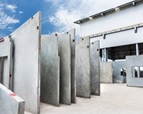You are here: Home » Construction » Concrete Testing » Petrographic Analysis
Petrographic Analysis
Looking for an independent, reputable third-party, petrographic analysis of concrete, mortars, building stone and other geological materials? Lucideon performs petrographic analysis to evaluate the integrity of concrete and understand the mineralogy of materials. Petrographic testing services are available from both our US and UK laboratories.
Petrographic analysis is a diagnostic tool for examining failures in concrete.
The service is available from both our US and UK laboratories.
Once onsite, we can carry out an initial visual examination of the area in order to ascertain possible causes of the problem and to determine the best position for taking samples. Our engineers can take core samples and return them to the laboratory where thin sections will be prepared for examination using Scanning Electron Microscopy (SEM) and Polarized Light Microscopy (PLM).
Petrographic analysis is carried out in accordance with both European and American standards: BS 1881-211:2016, ASTM C295, ASTM C856 and ASTM C457.
Benefits of petrographic examination include:
- Determining the present condition of previously placed concrete so that the decision to re-use or replace can be decided
- Establishing the root cause of surface scaling, spalling, aggregate pop-outs and abrasion
- Defining cracks by type and uncovering crack mechanisms
- Explaining causes of concrete degradation; primary mechanisms are:
- Alkali-Silica Reaction (ASR)
- Alkali-Carbonate Reaction (ACR)
- Sulfate attack.
- Effects of chemical attack (including chlorides)
- Assessing the entrained air content
- Establishing the water/cement ratio
- Determining the density, absorption and volume of permeable voids (as defined in ASTM C642)
- Revealing the root cause(s) of low compressive strength with key milestones at 7, 28 and 56 days
- Comparing hardened concrete to known mix designs
- Assessing fire damage.
Forensic analysis can be supplemented by additional techniques which also include, but are not limited to chemical analysis, SEM and X-Ray Diffraction (XRD).
Our Evaluations Can Answer the Following Types of Questions:
- Did the materials used match the concrete mix design?
- Is the air content entrapped and entrained porosity?
- Has it cured correctly?
- Is there evidence of deleterious degradation of the concrete?
- What is the geological provenance of the stone?
Test Methods We Perform Include:
Petrographic Analysis (ASTM C856) - A microstructural examination by optical and scanning electron microscopy (SEM) of the paste and aggregate on a prepared sample of concrete to look for features such as degree of cement hydration, microcracking, reaction products, breakdown of aggregate and evidence of poor freeze-thaw performance. A mineralogical assessment of the aggregate is also performed to determine if appropriate aggregate was used and if it caused any deleterious reactions.
Air Void Analysis (ASTM C457) - Performed on polished core cross-sections using state-of-the-art calibrated image analysis software. This analysis provides detailed information about the relative composition and distribution of coarse and fine aggregate, cement paste, entrained and entrapped air.
FTIR Analysis - Utilized to identify contaminants and verify the composition of binders, epoxies, coatings, and other organic materials.
Petrographic Analysis of Natural Stone (BS EN 12407) - Microscopic examination of macro and micro samples enables rock types to be described according to recognised standards and terminology (BS EN 12670) and defined. From the petrographic examination and knowledge of the origin of the stone, denomination criteria can be assigned (BS EN 12440). Provides an unambiguous definition of the stone.
Petrographic Analysis of Agglomerated Stone (BS EN 14618) - Provides standard means for describing agglomerated stone, these are products in which rock fragments are bonded to form a solid block that is then cut and polished as if it were natural stone.
Petrographic Analysis of Natural Stone Tiles (BS EN 12057) - Enables the characteristics of natural stone tiles to be assessed and described using microscopic examination.
Petrographic Analysis of Slate and Roofing Tiles (BS EN 12326-2) - Characteristics of natural slate tiles are evaluated for lamination and degradation using microscopic techniques.


